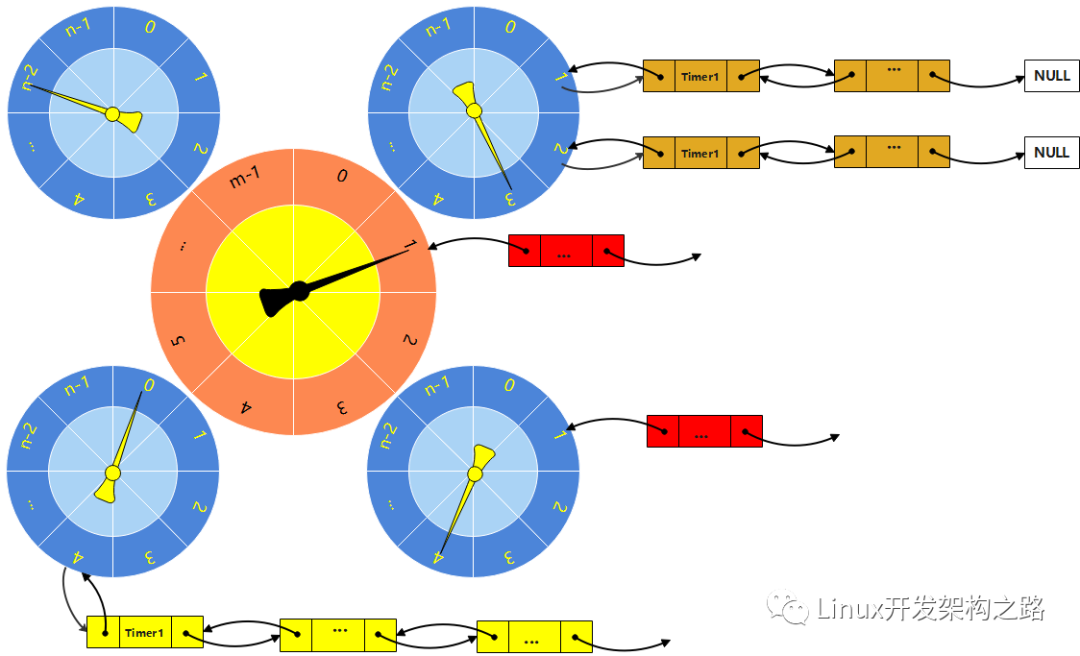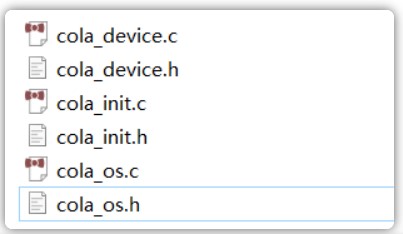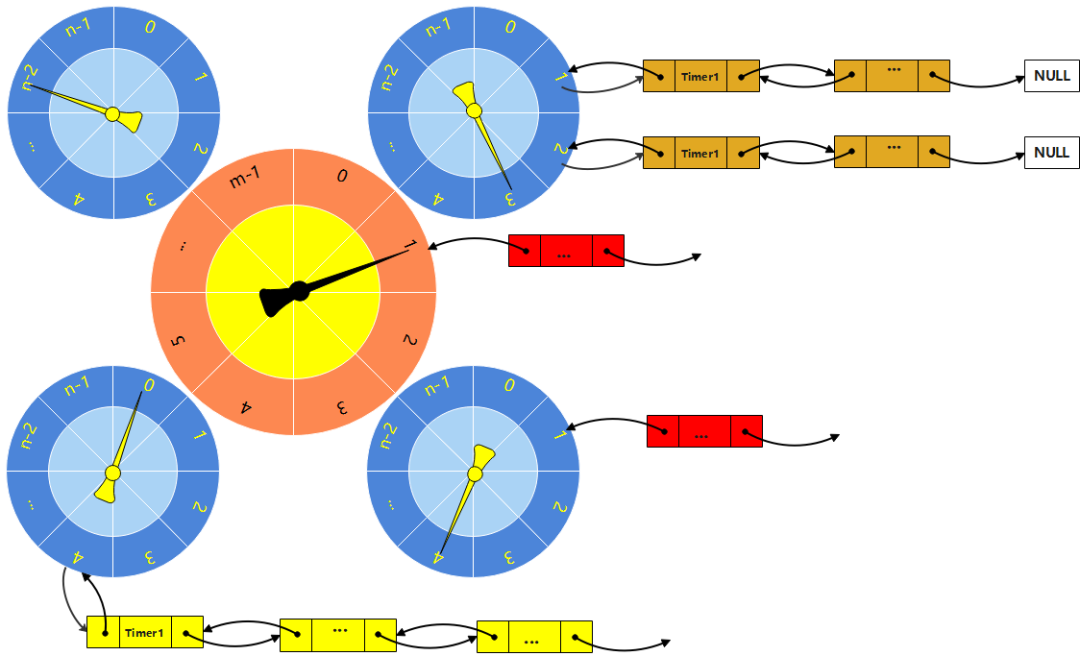一. 多級(jí)時(shí)間輪實(shí)現(xiàn)框架

上圖是5個(gè)時(shí)間輪級(jí)聯(lián)的效果圖。中間的大輪是工作輪,只有在它上的任務(wù)才會(huì)被執(zhí)行;其他輪上的任務(wù)時(shí)間到后遷移到下一級(jí)輪上,他們最終都會(huì)遷移到工作輪上而被調(diào)度執(zhí)行。
多級(jí)時(shí)間輪的原理也容易理解:就拿時(shí)鐘做說(shuō)明,秒針轉(zhuǎn)動(dòng)一圈分針轉(zhuǎn)動(dòng)一格;分針轉(zhuǎn)動(dòng)一圈時(shí)針轉(zhuǎn)動(dòng)一格;同理時(shí)間輪也是如此:當(dāng)?shù)图?jí)輪轉(zhuǎn)動(dòng)一圈時(shí),高一級(jí)輪轉(zhuǎn)動(dòng)一格,同時(shí)會(huì)將高一級(jí)輪上的任務(wù)重新分配到低級(jí)輪上。從而實(shí)現(xiàn)了多級(jí)輪級(jí)聯(lián)的效果。
1.1 多級(jí)時(shí)間輪對(duì)象

多級(jí)時(shí)間輪應(yīng)該至少包括以下內(nèi)容:
- 每一級(jí)時(shí)間輪對(duì)象
- 輪子上指針的位置
關(guān)于輪子上指針的位置有一個(gè)比較巧妙的辦法:那就是位運(yùn)算。比如定義一個(gè)無(wú)符號(hào)整型的數(shù):

通過(guò)獲取當(dāng)前的系統(tǒng)時(shí)間便可以通過(guò)位操作轉(zhuǎn)換為時(shí)間輪上的時(shí)間,通過(guò)與實(shí)際時(shí)間輪上的時(shí)間作比較,從而確定時(shí)間輪要前進(jìn)調(diào)度的時(shí)間,進(jìn)而操作對(duì)應(yīng)時(shí)間輪槽位對(duì)應(yīng)的任務(wù)。
為什么至少需要這兩個(gè)成員呢?
- 定義多級(jí)時(shí)間輪,首先需要明確的便是級(jí)聯(lián)的層數(shù),也就是說(shuō)需要確定有幾個(gè)時(shí)間輪。
- 輪子上指針位置,就是當(dāng)前時(shí)間輪運(yùn)行到的位置,它與真實(shí)時(shí)間的差便是后續(xù)時(shí)間輪需要調(diào)度執(zhí)行,它們的差值是時(shí)間輪運(yùn)作起來(lái)的驅(qū)動(dòng)力。
多級(jí)時(shí)間輪對(duì)象的定義
//實(shí)現(xiàn)5級(jí)時(shí)間輪 范圍為0~ (2^8 * 2^6 * 2^6 * 2^6 *2^6)=2^32
struct tvec_base
{
unsigned long current_index;
pthread_t thincrejiffies;
pthread_t threadID;
struct tvec_root tv1; /*第一個(gè)輪*/
struct tvec tv2; /*第二個(gè)輪*/
struct tvec tv3; /*第三個(gè)輪*/
struct tvec tv4; /*第四個(gè)輪*/
struct tvec tv5; /*第五個(gè)輪*/
};
1.2 時(shí)間輪對(duì)象

我們知道每一個(gè)輪子實(shí)際上都是一個(gè)哈希表,上面我們只是實(shí)例化了五個(gè)輪子的對(duì)象,但是五個(gè)輪子具體包含什么,有幾個(gè)槽位等等沒(méi)有明確(即struct tvec和struct tvec_root)。
#define TVN_BITS 6
#define TVR_BITS 8
#define TVN_SIZE (1
此外,每一個(gè)時(shí)間輪都是哈希表,因此它的類(lèi)型應(yīng)該至少包含兩個(gè)指針域來(lái)實(shí)現(xiàn)雙向鏈表的功能。這里我們?yōu)榱朔奖闶褂猛ㄓ玫膕truct list_head的雙向鏈表結(jié)構(gòu)。
1.3 定時(shí)任務(wù)對(duì)象

定時(shí)器的主要工作是為了在未來(lái)的特定時(shí)間完成某項(xiàng)任務(wù),而這個(gè)任務(wù)經(jīng)常包含以下內(nèi)容:
- 任務(wù)的處理邏輯(回調(diào)函數(shù))
- 任務(wù)的參數(shù)
- 雙向鏈表節(jié)點(diǎn)
- 到時(shí)時(shí)間
定時(shí)任務(wù)對(duì)象的定義
typedef void (*timeouthandle)(unsigned long );
struct timer_list{
struct list_head entry; //將時(shí)間連接成鏈表
unsigned long expires; //超時(shí)時(shí)間
void (*function)(unsigned long); //超時(shí)后的處理函數(shù)
unsigned long data; //處理函數(shù)的參數(shù)
struct tvec_base *base; //指向時(shí)間輪
};
在時(shí)間輪上的效果圖:

1.4 雙向鏈表
在時(shí)間輪上我們采用雙向鏈表的數(shù)據(jù)類(lèi)型。采用雙向鏈表的除了操作上比單鏈表復(fù)雜,多占一個(gè)指針域外沒(méi)有其他不可接收的問(wèn)題。而多占一個(gè)指針域在今天大內(nèi)存的時(shí)代明顯不是什么問(wèn)題。至于雙向鏈表操作的復(fù)雜性,我們可以通過(guò)使用通用的struct list結(jié)構(gòu)來(lái)解決,因?yàn)殡p向鏈表有眾多的標(biāo)準(zhǔn)操作函數(shù),我們可以通過(guò)直接引用list.h頭文件來(lái)使用他們提供的接口。
struct list可以說(shuō)是一個(gè)萬(wàn)能的雙向鏈表操作框架,我們只需要在自定義的結(jié)構(gòu)中定義一個(gè)struct list對(duì)象即可使用它的標(biāo)準(zhǔn)操作接口。同時(shí)它還提供了一個(gè)類(lèi)似container_of的接口,在應(yīng)用層一般叫做list_entry,因此我們可以很方便的通過(guò)struct list成員找到自定義的結(jié)構(gòu)體的起始地址。
關(guān)于應(yīng)用層的log.h, 我將在下面的代碼中附上該文件。如果需要內(nèi)核層的實(shí)現(xiàn),可以直接從linux源碼中獲取。
1.5 聯(lián)結(jié)方式
多級(jí)時(shí)間輪效果圖:

二. 多級(jí)時(shí)間輪C語(yǔ)言實(shí)現(xiàn)
2.1 雙向鏈表頭文件: list.h
提到雙向鏈表,很多的源碼工程中都會(huì)實(shí)現(xiàn)一系列的統(tǒng)一的雙向鏈表操作函數(shù)。它們?yōu)殡p向鏈表封裝了統(tǒng)計(jì)的接口,使用者只需要在自定義的結(jié)構(gòu)中添加一個(gè)struct list_head結(jié)構(gòu),然后調(diào)用它們提供的接口,便可以完成雙向鏈表的所有操作。這些操作一般都在list.h的頭文件中實(shí)現(xiàn)。Linux源碼中也有實(shí)現(xiàn)(內(nèi)核態(tài)的實(shí)現(xiàn))。他們實(shí)現(xiàn)的方式基本完全一樣,只是實(shí)現(xiàn)的接口數(shù)量和功能上稍有差別。可以說(shuō)這個(gè)list.h文件是學(xué)習(xí)操作雙向鏈表的不二選擇,它幾乎實(shí)現(xiàn)了所有的操作:增、刪、改、查、遍歷、替換、清空等等。這里我拼湊了一個(gè)源碼中的log.h函數(shù),終于湊夠了多級(jí)時(shí)間輪中使用到的接口。

#if !defined(_BLKID_LIST_H) && !defined(LIST_HEAD)
#define _BLKID_LIST_H
#ifdef __cplusplus
extern "C" {
#endif
/*
* Simple doubly linked list implementation.
*
* Some of the internal functions ("__xxx") are useful when
* manipulating whole lists rather than single entries, as
* sometimes we already know the next/prev entries and we can
* generate better code by using them directly rather than
* using the generic single-entry routines.
*/
struct list_head {
struct list_head *next, *prev;
};
#define LIST_HEAD_INIT(name) { &(name), &(name) }
#define LIST_HEAD(name)
struct list_head name = LIST_HEAD_INIT(name)
#define INIT_LIST_HEAD(ptr) do {
(ptr)- >next = (ptr); (ptr)- >prev = (ptr);
} while (0)
static inline void
__list_add(struct list_head *entry,
struct list_head *prev, struct list_head *next)
{
next- >prev = entry;
entry- >next = next;
entry- >prev = prev;
prev- >next = entry;
}
/**
* Insert a new element after the given list head. The new element does not
* need to be initialised as empty list.
* The list changes from:
* head → some element → ...
* to
* head → new element → older element → ...
*
* Example:
* struct foo *newfoo = malloc(...);
* list_add(&newfoo- >entry, &bar- >list_of_foos);
*
* @param entry The new element to prepend to the list.
* @param head The existing list.
*/
static inline void
list_add(struct list_head *entry, struct list_head *head)
{
__list_add(entry, head, head- >next);
}
/**
* Append a new element to the end of the list given with this list head.
*
* The list changes from:
* head → some element → ... → lastelement
* to
* head → some element → ... → lastelement → new element
*
* Example:
* struct foo *newfoo = malloc(...);
* list_add_tail(&newfoo- >entry, &bar- >list_of_foos);
*
* @param entry The new element to prepend to the list.
* @param head The existing list.
*/
static inline void
list_add_tail(struct list_head *entry, struct list_head *head)
{
__list_add(entry, head- >prev, head);
}
static inline void
__list_del(struct list_head *prev, struct list_head *next)
{
next- >prev = prev;
prev- >next = next;
}
/**
* Remove the element from the list it is in. Using this function will reset
* the pointers to/from this element so it is removed from the list. It does
* NOT free the element itself or manipulate it otherwise.
*
* Using list_del on a pure list head (like in the example at the top of
* this file) will NOT remove the first element from
* the list but rather reset the list as empty list.
*
* Example:
* list_del(&foo- >entry);
*
* @param entry The element to remove.
*/
static inline void
list_del(struct list_head *entry)
{
__list_del(entry- >prev, entry- >next);
}
static inline void
list_del_init(struct list_head *entry)
{
__list_del(entry- >prev, entry- >next);
INIT_LIST_HEAD(entry);
}
static inline void list_move_tail(struct list_head *list,
struct list_head *head)
{
__list_del(list- >prev, list- >next);
list_add_tail(list, head);
}
/**
* Check if the list is empty.
*
* Example:
* list_empty(&bar- >list_of_foos);
*
* @return True if the list contains one or more elements or False otherwise.
*/
static inline int
list_empty(struct list_head *head)
{
return head- >next == head;
}
/**
* list_replace - replace old entry by new one
* @old : the element to be replaced
* @new : the new element to insert
*
* If @old was empty, it will be overwritten.
*/
static inline void list_replace(struct list_head *old,
struct list_head *new)
{
new- >next = old- >next;
new- >next- >prev = new;
new- >prev = old- >prev;
new- >prev- >next = new;
}
/**
* Retrieve the first list entry for the given list pointer.
*
* Example:
* struct foo *first;
* first = list_first_entry(&bar- >list_of_foos, struct foo, list_of_foos);
*
* @param ptr The list head
* @param type Data type of the list element to retrieve
* @param member Member name of the struct list_head field in the list element.
* @return A pointer to the first list element.
*/
#define list_first_entry(ptr, type, member)
list_entry((ptr)- >next, type, member)
static inline void list_replace_init(struct list_head *old,
struct list_head *new)
{
list_replace(old, new);
INIT_LIST_HEAD(old);
}
/**
* list_entry - get the struct for this entry
* @ptr: the &struct list_head pointer.
* @type: the type of the struct this is embedded in.
* @member: the name of the list_struct within the struct.
*/
#define list_entry(ptr, type, member)
((type *)((char *)(ptr)-(unsigned long)(&((type *)0)- >member)))
/**
* list_for_each - iterate over elements in a list
* @pos: the &struct list_head to use as a loop counter.
* @head: the head for your list.
*/
#define list_for_each(pos, head)
for (pos = (head)- >next; pos != (head); pos = pos- >next)
/**
* list_for_each_safe - iterate over elements in a list, but don't dereference
* pos after the body is done (in case it is freed)
* @pos: the &struct list_head to use as a loop counter.
* @pnext: the &struct list_head to use as a pointer to the next item.
* @head: the head for your list (not included in iteration).
*/
#define list_for_each_safe(pos, pnext, head)
for (pos = (head)- >next, pnext = pos- >next; pos != (head);
pos = pnext, pnext = pos- >next)
#ifdef __cplusplus
}
#endif
#endif /* _BLKID_LIST_H */
這里面一般會(huì)用到一個(gè)重要實(shí)現(xiàn):container_of, 它的原理這里不敘述
2.2 調(diào)試信息頭文件: log.h
這個(gè)頭文件實(shí)際上不是必須的,我只是用它來(lái)添加調(diào)試信息(代碼中的errlog(), log()都是log.h中的宏函數(shù))。它的效果是給打印的信息加上顏色,效果如下:

log.h的代碼如下:
#ifndef _LOG_h_
#define _LOG_h_
#include < stdio.h >
#define COL(x) "?33[;" #x "m"
#define RED COL(31)
#define GREEN COL(32)
#define YELLOW COL(33)
#define BLUE COL(34)
#define MAGENTA COL(35)
#define CYAN COL(36)
#define WHITE COL(0)
#define GRAY "?33[0m"
#define errlog(fmt, arg...) do{
printf(RED"[#ERROR: Toeny Sun:"GRAY YELLOW" %s:%d]:"GRAY WHITE fmt GRAY, __func__, __LINE__, ##arg);
}while(0)
#define log(fmt, arg...) do{
printf(WHITE"[#DEBUG: Toeny Sun: "GRAY YELLOW"%s:%d]:"GRAY WHITE fmt GRAY, __func__, __LINE__, ##arg);
}while(0)
#endif
2.3 時(shí)間輪代碼: timewheel.c
/*
*毫秒定時(shí)器 采用多級(jí)時(shí)間輪方式 借鑒linux內(nèi)核中的實(shí)現(xiàn)
*支持的范圍為1 ~ 2^32 毫秒(大約有49天)
*若設(shè)置的定時(shí)器超過(guò)最大值 則按最大值設(shè)置定時(shí)器
**/
#include < stdio.h >
#include < stdlib.h >
#include < string.h >
#include < unistd.h >
#include < pthread.h >
#include < sys/time.h >
#include "list.h"
#include "log.h"
#define TVN_BITS 6
#define TVR_BITS 8
#define TVN_SIZE (1
2.4 編譯運(yùn)行
toney@ubantu:/mnt/hgfs/em嵌入式學(xué)習(xí)記錄/4. timerwheel/2. 多級(jí)時(shí)間輪$ ls
a.out list.h log.h mutiTimeWheel.c
toney@ubantu:/mnt/hgfs/em嵌入式學(xué)習(xí)記錄/4. timerwheel/2. 多級(jí)時(shí)間輪$ gcc mutiTimeWheel.c -lpthread
toney@ubantu:/mnt/hgfs/em嵌入式學(xué)習(xí)記錄/4. timerwheel/2. 多級(jí)時(shí)間輪$ ./a.out
[#DEBUG: Toeny Sun: mytimer:370]:100
[#DEBUG: Toeny Sun: mytimer:370]:100
[#DEBUG: Toeny Sun: mytimer:370]:100
[#DEBUG: Toeny Sun: mytimer:370]:100
[#DEBUG: Toeny Sun: mytimer:370]:100
[#DEBUG: Toeny Sun: mytimer:370]:100
[#DEBUG: Toeny Sun: mytimer:370]:100
[#DEBUG: Toeny Sun: mytimer:370]:100
[#DEBUG: Toeny Sun: mytimer:370]:100
[#DEBUG: Toeny Sun: mytimer:370]:100
[#DEBUG: Toeny Sun: mytimer:370]:100
[#DEBUG: Toeny Sun: mytimer:370]:100
[#DEBUG: Toeny Sun: mytimer:370]:100
[#DEBUG: Toeny Sun: mytimer:370]:100
[#DEBUG: Toeny Sun: mytimer:370]:100
[#DEBUG: Toeny Sun: mytimer:370]:100
[#DEBUG: Toeny Sun: mytimer:370]:100
[#DEBUG: Toeny Sun: mytimer:370]:100
[#DEBUG: Toeny Sun: mytimer:370]:100
[#DEBUG: Toeny Sun: mytimer:370]:100
[#DEBUG: Toeny Sun: mytimer:370]:100
[#DEBUG: Toeny Sun: mytimer:370]:100
[#DEBUG: Toeny Sun: mytimer:370]:100
[#DEBUG: Toeny Sun: mytimer:370]:100
[#DEBUG: Toeny Sun: mytimer:370]:100
[#DEBUG: Toeny Sun: mytimer:370]:100
[#DEBUG: Toeny Sun: mytimer:370]:100
[#DEBUG: Toeny Sun: mytimer:370]:100
從結(jié)果可以看出:如果添加的定時(shí)任務(wù)是比較耗時(shí)的操作,那么后續(xù)的任務(wù)也會(huì)被阻塞,可能一直到超時(shí),甚至一直阻塞下去,這個(gè)取決于當(dāng)前任務(wù)是否耗時(shí)。這個(gè)理論上是絕不能接受的:一個(gè)任務(wù)不應(yīng)該也不能去影響其他的任務(wù)吧。但是目前沒(méi)有對(duì)此問(wèn)題進(jìn)行改進(jìn)和完善,以后有機(jī)會(huì)再繼續(xù)完善吧。
-
參數(shù)
+關(guān)注
關(guān)注
11文章
1860瀏覽量
32431 -
函數(shù)
+關(guān)注
關(guān)注
3文章
4346瀏覽量
62979 -
代碼
+關(guān)注
關(guān)注
30文章
4828瀏覽量
69063
發(fā)布評(píng)論請(qǐng)先 登錄
相關(guān)推薦
使用cola_os軟件定時(shí)器實(shí)現(xiàn)時(shí)間片輪詢(xún)框架

Linux編程之經(jīng)典多級(jí)時(shí)間輪定時(shí)器(C語(yǔ)言版)
多級(jí)時(shí)間輪定時(shí)器的原理及編程實(shí)現(xiàn)方案

輕量級(jí)多級(jí)菜單控制框架
基于J2EE的數(shù)據(jù)通用性操作框架的研究與實(shí)現(xiàn)
制作庫(kù)時(shí)如何分多級(jí)菜單
基于RT-Thread+RA6M4的麥輪結(jié)構(gòu)的底盤(pán)運(yùn)動(dòng)控制系統(tǒng)設(shè)計(jì)案例
LCD多級(jí)菜單具體實(shí)現(xiàn)
簡(jiǎn)單時(shí)間輪算法詳解
定時(shí)器實(shí)現(xiàn)原理——時(shí)間輪
使用風(fēng)扇實(shí)現(xiàn)多級(jí)通風(fēng)

Linux 編程之經(jīng)典多級(jí)時(shí)間輪定時(shí)器(上)





 多級(jí)時(shí)間輪實(shí)現(xiàn)框架
多級(jí)時(shí)間輪實(shí)現(xiàn)框架










評(píng)論